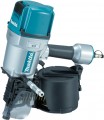Air consumption
Normal air consumption during operation of the pneumatic nailer/stapler (see "Type"). Indicated per one hit; knowing the performance of the tool (see below), it is possible to assess whether the performance of the existing compressor is enough for the normal operation of the stapler. For example, for a model that produces 150 beats / min and consumes 3 liters per beat, ideally at least 3 * 150 = 450 liters of air per minute are needed. At the same time, in fact, even the most experienced operator finds it difficult to maintain a pace of 90 bpm or more; therefore, in fact, even relatively low-power compressors that do not reach the perfect value often turn out to be quite suitable for "quick-fire" staplers.
Magazine angle
The angle at which the magazine is set in the tool. Note that in this case, the angle is measured relative to the perpendicular to the body, more precisely, to the direction of the “shooting” of the fastener; in other words, if the angle of inclination is 0 °, this means that the store is strictly perpendicular to the body. This makes quite a practical sense: an inclined magazine makes it easier to work in hard-to-reach places, driving fasteners at an angle and some other specific tasks, and the greater the deviation of the magazine from the perpendicular, the more pronounced these advantages. At the same time, the real need for such a design is not always required, so many staplers (especially entry-level ones) have a perpendicular magazine, and in such cases the angle of inclination (0 °) is not indicated at all.
Also note that fasteners (especially branded ones, for a tool of a certain brand) can be sold in packs designed for a specific store angle; in such packs, the parts themselves are connected with a slope corresponding to this angle.
Min. nail diameter
The smallest thickness of nails (see "Type of fastener") that the stapler can work with.
A nail that is too thin is just as undesirable for a tool as one that is too thick: already in the store, such parts can hang out, and there is no question of correct “shooting” at all. Therefore, this limitation should definitely be taken into account when choosing, especially if you plan to work with nails of small thickness. The most "thin" modern staplers have a minimum limit of about 1 mm, and in professional models it can exceed 2.5 mm and even 3 mm.
Max. nail diameter
The largest thickness of nails (see "Type of fastener") that the stapler can work with.
Thick nails require not only the appropriate size of the magazine and feeder, but also significant effort is required to drive them. Therefore, the larger the maximum allowable nail diameter, the more powerful, heavier and more expensive the tool, usually. Professional pneumatic nailers can be compatible with fasteners of 3.5 mm or more, but for entry-level tools, a thickness of 1.2 — 1.5 mm is often more than enough.

